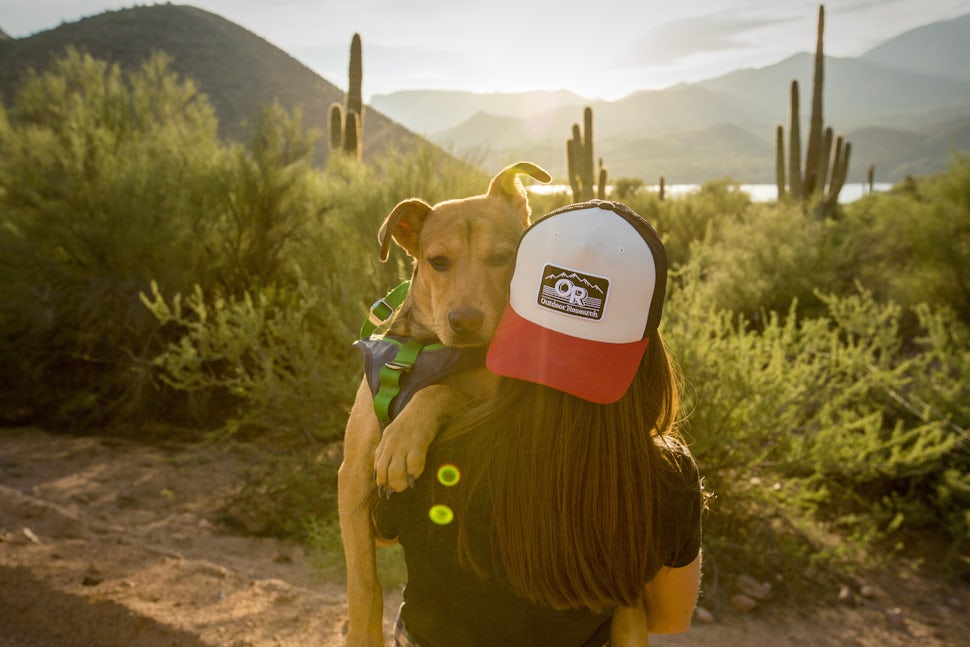6 Trail Dangers Your Dog Will Encounter
Keep your best friend (and yourself) safe on your next hike.

Why hike alone when you can hike with your trusted canine companion? Hiking with your dog is a natural way to amplify your enjoyment of the outdoors. Most dogs love a good dose of outdoor adventure, and as humans, we crave the opportunity to share that adventure with our four-legged friends.
When you hike with your dog, you’re responsible for his safety just as much as you are responsible for your own. But how do you know what to watch for and how to protect your dog on the trail?
1. Heat Stroke
You think you’re sweating up a storm during your afternoon hike? Think about how your dog must feel. Dogs do not sweat through their skin like humans - they release heat primarily by panting and sweating through foot pads and the nose. If a dog cannot expel heat, his internal body temperature will rise to dangerous temperatures that can lead to organ damage and even death. Play it safe: Avoid hiking during the hottest part of the day, keep your dog cool with frequent water breaks and rests, and make sure he has plenty of shade along the way. Signs of heat stroke include restlessness, heavy panting, excessive drooling, hyperventilation, and behavioral signs of anxiety. Before hiking with your dog, evaluate him for potential health concerns that could make him more susceptible to heat stroke (young or old age, thick hair, overweight, poor heart or lungs, short-nosed or flat-faced breeds). And, if you do notice your dog suffering from symptoms of heat stroke, seek immediate emergency medical treatment to stop lasting organ damage in its tracks.
2. Wildlife
From porcupines, skunks, and moose to bears, mountain lions, and coyotes, the great outdoors offer ample opportunity for your dog to run afoul of wildlife. If your dog disturbs a predator, the situation could endanger you as well as your dog may lead the predator back to you. Keep your dog leashed to prevent him from chasing wildlife and getting both of you into dangerous situations. It’s not just the big animals you need to watch out for: It can be difficult to keep inquiring dog noses out of cracks and from underneath rocks where rattlesnakes may be hiding. Stay in the middle of trails and keep your dog away from rocks and cracks where snakes may be hiding out.
Photo: Kevin Kaminski
3. Disease
A host of potential diseases can await your dog on the trail. In areas where ticks are prevalent, contracting Lyme disease can be a real threat. Mosquitos can also transmit heartworm disease - luckily, this is easily preventable with a monthly chewable tablet from your veterinarian. Drinking from contaminated water or or soil can lead to giardiasis and leptospirosis. There’s also no telling what your dog may contract from eating scat or dead animal carcasses he finds. Before hiking with your dog, make a trip to your veterinarian to make sure your pup is properly vaccinated against anything he may encounter in the wild. An ounce of prevention is worth a pound of cure.
4. Hunters
Before hitting the trail, make sure you know if the area you will be hiking in is a popular area for hunters. Even if it is not, keep in mind that some hikers carry handguns with them to use as self-protection while on the trail. If your dog isn’t properly identified as a pet, he or she could be mistaken as a bear or some other threatening wildlife. Make sure your dog wears a bright collar and a bear bell so he can be easily distinguished (this helps give wildlife plenty of warning that your dog is nearby, too). Light-up collars are a great idea for night hikes or camping.
Photo: Kate Wessels
5. Hidden Obstacles
If you are on an off-leash trail, be sure your dog stays close and that you know what is in his path at all times. When he’s jazzed up about exploring the great outdoors, he won’t notice if he’s about to fall into a hole or skewer himself on a sharp branch or protruding stick.
6. Traps
A veterinarian in Montana recounted the time she was hiking in a popular recreational area and her dog got his leg caught in a leg hold trap a trapper had set less than 10 feet off the trail. Luckily, the trappers were nearby and were able to get the dog's leg out with minimal damage. Educate yourself on how to remove leg hold traps and suffocating wire snares, and make sure you know the areas where trapping is permitted.
Cover photo: Kevin Kaminski
We want to acknowledge and thank the past, present, and future generations of all Native Nations and Indigenous Peoples whose ancestral lands we travel, explore, and play on. Always practice Leave No Trace ethics on your adventures and follow local regulations. Please explore responsibly!
Do you love the outdoors?
Yep, us too. That's why we send you the best local adventures, stories, and expert advice, right to your inbox.










